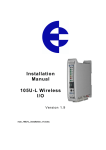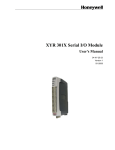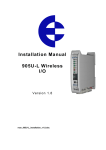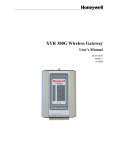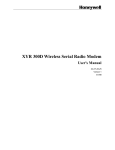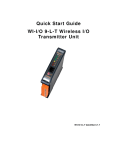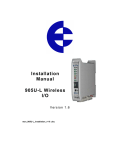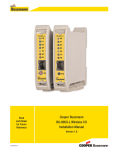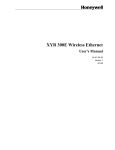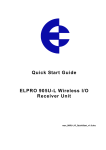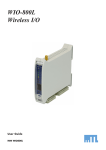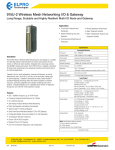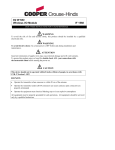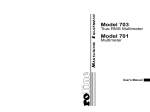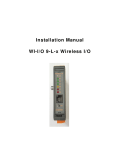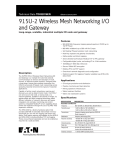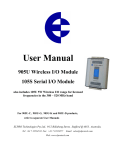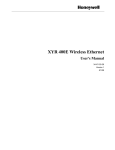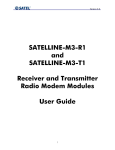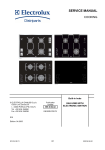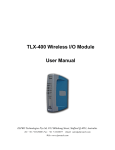Download XYR 300L Wireless I/O User`s Manual
Transcript
XYR 300L Wireless I/O User's Manual 34-XY-25-22 Version 1 5/1/08 Notices and Trademarks Copyright 2008 by Honeywell International Inc. Version 1 May 1, 2008 While this information is presented in good faith and believed to be accurate, Honeywell disclaims the implied warranties of merchantability and fitness for a particular purpose and makes no express warranties except as may be stated in its written agreement with and for its customers. In no event is Honeywell liable to anyone for any indirect, special or consequential damages. The information and specifications in this document are subject to change without notice. Honeywell, PlantScape, Experion PKS, and TotalPlant are registered trademarks of Honeywell International Inc. Other brand or product names are trademarks of their respective owners. Honeywell International Process Solutions 2500 West Union Hills Phoenix, AZ 85027 1-800 343-0228 ii XYR 300L Wireless I/O User's Manual Version 1 5/1/08 About This Document This document is the XYR 300L Wireless Installation Manual that describes how to install your XYR 300L units and contains important information for installing your units with other equipment. Note If your network only contains one transmitter and receiver pair, you should also read the XYR 300L QuickStart Guides. This document contains the following sections: Section Read this section if you want to … Basic steps for using your unit Learn the basic steps for installing and using your unit. Factory default configuration Understand how the transmitter sends information to the receiver. Unit components Understand the different parts of your unit. Antenna installation Learn how to install an antenna with your unit. Resetting factory defaults Reset your unit to the original factory default settings. Linking transmitter and receiver units Link your units to work as a dedicated pair. Safety information Understand important safety information related to your unit. NOTE: You must read this information before installing your unit. Know technical information about your unit. Specifications For more information, see the next sections. REFERENCES The following list identifies all documents that may be sources of reference for material discussed in this publication. Document Title Getting Started with Honeywell OneWireless solutions XYR3000 MSG How to build an XYR3000 system TERMINOLOGY The following acronyms are used in the document. Acronyms Model numbers XYR300X XYR3001, XYR3002 XYR301X XYR3011, XYR3012, XYR3013 XYR300G-X XYR300G-M, XYR300G-E Version 1 5/1/08 XYR 300L Wireless I/O User's Manual iii Support and Contact Information United States and Canada Contact: Honeywell Solution Support Center Phone: 1-800 822-7673. In Arizona: 602- 313-5558 Calls are answered by dispatcher between 6:00 am and 4:00 pm Mountain Standard Time. Emergency calls outside normal working hours are received by an answering service and returned within one hour. Facsimile: (602) 313-3293 Mail: Honeywell TAC, MS P13 2500 West Union Hills Drive Phoenix, AZ, 85027 World Wide Web Honeywell Solution Support Online: http://www.honeywell.com/ps Elsewhere Call your nearest Honeywell office. Training Classes Honeywell Automation College: http://www.automationcollege.com iv XYR 300L Wireless I/O User's Manual Version 1 5/1/08 Symbol Definitions The following table lists those symbols used in this document to denote certain conditions. Symbol Definition ATTENTION: Identifies information that requires special consideration. TIP: Identifies advice or hints for the user, often in terms of performing a task. CAUTION Indicates a situation which, if not avoided, may result in equipment or work (data) on the system being damaged or lost, or may result in the inability to properly operate the process. CAUTION: Indicates a potentially hazardous situation which, if not avoided, may result in minor or moderate injury. It may also be used to alert against unsafe practices. CAUTION symbol on the equipment refers the user to the product manual for additional information. The symbol appears next to required information in the manual. WARNING: Indicates a potentially hazardous situation, which, if not avoided, could result in serious injury or death. WARNING symbol on the equipment refers the user to the product manual for additional information. The symbol appears next to required information in the manual. WARNING, Risk of electrical shock: Potential shock hazard where HAZARDOUS LIVE voltages greater than 30 Vrms, 42.4 Vpeak, or 60 VDC may be accessible. ESD HAZARD: Danger of an electro-static discharge to which equipment may be sensitive. Observe precautions for handling electrostatic sensitive devices. Protective Earth (PE) terminal: Provided for connection of the protective earth (green or green/yellow) supply system conductor. Functional earth terminal: Used for non-safety purposes such as noise immunity improvement. NOTE: This connection shall be bonded to Protective Earth at the source of supply in accordance with national local electrical code requirements. Earth Ground: Functional earth connection. NOTE: This connection shall be bonded to Protective Earth at the source of supply in accordance with national and local electrical code requirements. Chassis Ground: Identifies a connection to the chassis or frame of the equipment shall be bonded to Protective Earth at the source of supply in accordance with national and local electrical code requirements. Version 1 5/1/08 XYR 300L Wireless I/O User's Manual v Contents Installing your unit ................................................................................................................................1 Unit components and connections .......................................................................................................3 Transmitter unit ...................................................................................................................................................... 3 Receiver unit........................................................................................................................................................... 6 Installing the antenna ...........................................................................................................................8 Supported antennas............................................................................................................................................... 8 Radio transmission distances.............................................................................................................................. 11 Installing and earthing antennas ......................................................................................................................... 12 Dipole and collinear antennas ............................................................................................................................. 13 Dipole antennas .............................................................................................................................................. 13 Collinear antennas .......................................................................................................................................... 13 Yagi antennas....................................................................................................................................................... 15 Installing the power supply .................................................................................................................17 Inputs and outputs__________________________________________________________18 Digital inputs ......................................................................................................................................................... 19 Analog input.......................................................................................................................................................... 21 Thermocouple input ............................................................................................................................................. 24 Pulse input ............................................................................................................................................................ 25 Installing and configuring the unit........................................................................................................................ 26 Installing the unit.................................................................................................................................27 Configuring your units ........................................................................................................................28 Testing your units ...............................................................................................................................29 Unit specifications __________________________________________________________30 Transmitter unit...................................................................................................................................30 Receiver unit.......................................................................................................................................30 Ancillary hardware reference information...........................................................................................31 RS232 serial cable ............................................................................................................................................... 31 Index _____________________________________________________________________32 vi XYR 300L Wireless I/O User's Manual Version 1 5/1/08 Safety information Thank you for selecting the XYR 300L for your telemetry needs. We trust it will give you many years of valuable service. To ensure your XYR 300L enjoys a long life, double-check ALL your connections with the Installation Guide before powering on the module. WARNING: Incorrect termination of supply wires may cause internal damage and will void warranty. Exposure to RF energy is an important safety consideration. The FCC has adopted a safety standard for human exposure to radio frequency electromagnetic energy emitted by FCC regulated equipment as a result of its actions in Docket 93-62 and OET Bulletin 65 Edition 97-01. FCC Notice when used in USA: XYR 300X Wireless I/O Module Part Additional information 15 This device has been tested and found to comply with the limits for a Class B digital device, pursuant to Part15 of the FCC rules (Code of Federal Regulations 47CFR Part 15). Operation is subject to the condition that this device does not cause harmful interference. 90 This device has been type accepted for operation by the FCC in accordance with Part90 of the FCC rules (47CFR Part 90). See the label on the unit for the specific FCC ID and any other certification designations. Industry Canada: XYR 300X Wireless I/O Module RSS-119 - This device has been type accepted for operation by Industry Canada in accordance with RSS-119 of the Industry Canada rules. See the label on the unit for the specific Industry Canada certification number and any other certification designations. NOTE: Any changes or modifications not expressly approved by Honeywell Technologies P/L could void the user’s authority to operate this equipment. To operate this equipment legally the user must obtain a radio-operating license from the government agency. This is done so the government can coordinate radio users in order to minimize interference. Safety information - FCC Notice This device complies with Part 15.247 of the FCC Rules. Operation is subject to the following two conditions: This device may not cause harmful interference; and This device must accept any interference received, including interference that may cause undesired operation NOTE: This equipment is suitable for use in Class 1 Division 2 groups A, B and C or non-hazardous locations only. **IMPORTANT ELECTRICAL SAFETY INFORMATION** In order to comply with Electrical Safety Regulations, this module must be installed in an Electrical AND Fire enclosure. This enclosure may be a single or multiple enclosures. Access to the module Installing your unit This section describes how to install your unit and contains the following sections: Step Description For more information, see … 1 – Read the safety information Lets you understand important safety information related to your unit. Safety information on page 1. NOTE: You must read this information before installing your unit. Version 1 5/1/08 XYR 300L Wireless I/O User's Manual 1 2 – Get to know the unit features Understand the basic features of your unit. Unit components and connections on page 3. 3 – Install the antenna Learn how to install an antenna with your unit. Installing the antenna on page 8. 4 – Install the power supply Learn how to install a power supply for your unit. Installing the power supply on page 17. 5 – Install the units Learn how to install your unit. Installing the unit on page 27. 6 – Linking and configuring the unit Learn how to link and configure your units to transmit and receive information. Configuring your units on page 28. 7 – Test the unit Understand the principles for testing your units. Testing your units on page 29. Note To ensure internal surge protection works correctly, you must earth each unit using the Earth terminal. For more information, see the next sections. 2 XYR 300L Wireless I/O User's Manual Version 1 5/1/08 Unit components and connections This section shows the components and terminal connections for the transmitter and receiver units. Transmitter unit The XYR 300L I/O transmitter unit has the following components and terminal connections: Earth Wire Lug underneath Unit Version 1 5/1/08 XYR 300L Wireless I/O User's Manual 3 The front panel contains the following components: SMA antenna connector RS232 configuration port Rotary switch for set-point settings The triangle on the rotary switch indicates the current position, for example: Set Point NOTE: To avoid damaging the rotary switch, use a screwdriver to change the position. The rotary switch controls the setpoint levels on the Analog and Thermocouple inputs. 4 XYR 300L Wireless I/O User's Manual Version 1 5/1/08 The LEDs on the front panel indicate the unit status: LED Status Indicates None No power supply. OK LED Green Current status of the unit OK. OK LED Red Fault condition detected in unit. TX Led Flashes Transmitting Message. PG LED on Configuration Cable Connected. Input LED ON Input LEDS (i.e. D1, D2, SP, AZ.) light when the corresponding input is active. All LEDs medium flash Version 1 5/1/08 D1 Digital Input 1 is active (Low). D2 Digital Input 2 is active. SP Analog Setpoint is active. AZ Analog Input is zero mA Medium speed flash (1.6HZ) indicates the module is halfway through the configuration process. Medium flash also happens when you set the rotary switch to position 0 when powering on the unit. XYR 300L Wireless I/O User's Manual 5 Receiver unit Your XYR 300L -R unit has the following components and terminal connections: DC LOAD DO 2 - - NOT USED - NOT USED DO 3 DO 2 - DO 1 + POWER SUPPLY - AO DO 1 LOAD Max. 30VDC 500mA + For inductive load, use surge diodes + LOAD SYSTEM OK COMMS FAIL COMMON + 24V + - DO 3 - AC LOAD ANALOG OUTPUT Max. analog load 900 ohm + - + POWER SUPPLY 9 – 30 VDC 250mA @ 12V 125mA @ 24V 6 DO contacts are rated at 1A, 250VAC For good engineering practice, use a surge diode for DC loads and a surge capacitor (10nF 250V) for AC loads XYR 300L Wireless I/O User's Manual Version 1 5/1/08 The front panel contains the following components: SMA antenna connector RS232 configuration port Rotary switch for set-point settings The LEDs on the front panel indicate the unit status: LED Status Indicates None No power supply. OK LED Green Current status of the unit OK. OK LED Red Fault condition detected in unit. RX Led Flashes Receiving Message. CF Led ON Module Communication Failure Output is active. PG LED on Configuration Cable Connected. Output LED ON The Output LEDS (i.e. D1, D2, D3) light when the corresponding output is active. LEDs with RSSI Push Button Pressed Output LED flashing quickly Version 1 5/1/08 D1 Relay output D1 is ON (Contact Closed). D2 Relay Output D2 is ON. D3 Relay Output D3 is ON. When you press the RSSI push button, the unit shows the signal strength by lighting the LEDs from the bottom to the top. Signal strength is the strength of the last message received that was addressed to this station. LED Signal Strength LED Signal Strength D1 More than -85 dBm RX More than -100 dBm D2 More than -90 dBm CF More than -105 dBm D3 More than -95 dBm PG Always on during RSSI test If an output is in communication failure, the corresponding LED flashes at 5 Hz. D1 Relay Output D1 is in communication failure. D2 Relay Output D2 is in communication failure. D3 Relay Output D3 is in communication failure. PG Analog output is in communications failure. XYR 300L Wireless I/O User's Manual 7 Installing the antenna This section explains how to install your antenna and contains the following sections: Section Description For more information, see … Supported antennas and cables Details the antennas and cables you can use with the units. Supported antennas on page 8. Radio transmission distances Details the distances for reliable operation. Radio transmission distances on page 11. Installing and earthing antennas Details important information about installing and earthing antennas. Installing and earthing antennas on page 12 Dipole and collinear antennas Details important information about using dipole and collinear antennas. Dipole and collinear antennas on page 13. Yagi antennas Details important information about using Yagi antennas. Yagi antennas on page 15. For more information, see the next sections. Supported antennas You can use the following antennas with the units: Antenna Additional information Total gain (including cable) WH900 Whip antenna for mounting directly onto the module - operation up to ½ mile (1 km). -6 dBi CFD890EL 0 dBi Dipole antenna with 15’ of Cellfoil cable and SMA connector. 0 dBi SG900EL 5dBi Collinear omni-directional antenna with N-type connector. 5 dBi SG900-6 8dBi Collinear omni-directional antenna with N-type connector. 8 dBi YU6/900 10dBi Yagi directional antenna with N-type connector. 10 dBi YU16/900 15dBi Yagi directional antenna with N-type connector. 15 dBi You can use the following cables with the units: The following table shows compatible cables for different antennas when used with the XYR 300L I/O: 8 Antenna North America Australia/NZ SG900EL Any cable. CC10 or CC20. SG900-6 Any cable. CC20. YU6/900 CC20. External cable with loss > 9dB. YU16/900 External cable with loss > 9dB. External cable with loss > 15 dB XYR 300L Wireless I/O User's Manual Version 1 5/1/08 You must carefully select antennas for XYR 300L I/O modules to avoid contravening the maximum power limit on the unlicensed channel. The net gain of the antenna/cable configuration should be no more than 6dB in North America (USA, Canada, Mexico) and no more than 0 dB in Australia / New Zealand. Note The net gain of an antenna/cable configuration is the gain of the antenna (in dBi) less the loss in the coaxial cable (in dB). For example, an SG900-6 antenna with a CC20/900 cable has a net gain of 2dB (i.e. +8 dB – 6 dB) at 900 MHz. The following table details the gains of some typical antennas: Antenna Gain (dBi) Dipole with integral 3m cable 0 Dipole without cable 2 5dBi Collinear (3dBd) 5 8dBi Collinear (6dBd) 8 3 element Yagi 5 6 element Yagi 10 The following table details losses for typical cables: Cable Loss (dB per 10m) at 900 MHz RG58 -5 RG213 -2.5 Cellfoil -3 Version 1 5/1/08 XYR 300L Wireless I/O User's Manual 9 Radio transmission distances The unit will operate reliably over large distances depending on the: Antenna type; Antenna location; Amount of radio interference; and Radio path obstructions (e.g. hills or trees). Typical reliable distances are: Area Distance Additional information USA/Canada 20+ miles 6dB net gain antenna configuration permitted (4W Equivalent RF power permitted). Australia/NZ 20+ km Unity gain antenna configuration (1W Equivalent RF power permitted). To achieve these distance, you must elevate at least one site on a hill or transmission tower. Modules will operate reliably with some radio path obstruction; however obstructions also reduce the reliable distance. Note You must test all obstructed paths to check the reliability of the path. You can achieve maximum transmission distances if the radio path has “line of sight”. For example, raising antennas above intermediate obstructions including hills, trees, etc. Obstructions reduce the range; however they may not prevent a reliable path. The closer the obstruction is to the antenna, the greater the blocking effect. For example, a group of trees around the antenna is a larger obstruction than a group of trees further away from the antenna. You can achieve longer distances by mounting one antenna on top of a hill. Note Due to the earth’s curvature, you must elevate antennas higher than the ground level between the antennas for longer paths (greater than 3 miles / 5 km). The unit can tolerate larger amounts of obstructions for shorter distances. For very short distances, you can also mount the antennas inside buildings. If two XYR 300X modules cannot communicate reliably, you can use a third XYR 300X module as a “repeater” to receive and re-transmit messages. This module may also have input/output (I/O) signals connected to it and form part of the I/O network. 10 XYR 300L Wireless I/O User's Manual Version 1 5/1/08 Installing and earthing antennas You must connect an antenna to each module using the SMA connector at the top of the enclosure. Honeywell recommends carefully taping the connections between the antenna and coaxial cable to prevent moisture ingress. Moisture ingress in the coaxial cable is a common cause of radio system problem as it greatly increases the radio losses. Honeywell recommends taping the connection with three layers of tape: Layer Tape 1 PVC tape. 2 Vulcanising tape (e.g. 3M 23 tape). 3 Additional layer of PVC UV-stabilized insulating tape. The first tape layer lets you easily inspect the joint if required as you can easily remove the vulcanising seal. Note You must effectively earth all masts for mast-mounted antennas to avoid lightning surges. We also recommend using a coaxial surge diverter for antennas mounted outside industrial plant environments. If the antenna is not already shielded from lightning strike by an adjacent earthed structure, you can provide shielding by installing a lightning rod above the antenna. You should connect the antenna to the module using 50 ohm coaxial cable (e.g. RG58 or RG213) terminated with a male coaxial connector, The higher the antenna is mounted, the greater the transmission range; however as the length of coaxial cable increases so do cable losses. For use on unlicensed frequency channels, there are several types of antenna suitable for use. If you mount antennas on elevated masts, you should effectively earth the masts to avoid lightening surges. The XYR 300L radios are fitted with surge protection. Note For high lightening risk areas, Honeywell recommends additional surge suppression devices. If the antenna is not already shielded from lightening strike by an adjacent earthed structure, you can install a lightening rod to provide shielding. Version 1 5/1/08 XYR 300L Wireless I/O User's Manual 11 Dipole and collinear antennas This section contains important information for using dipole and collinear antennas. For more information, see the next sections. Dipole antennas Unity gain dipole antennas are commonly used on unlicensed channels. The dipole antenna does not provide any gain, so the power transmitted from the antenna is the same as the power out of the module. A dipole antenna that comes supplied with integral 15 ft cable does not require additional coaxial cable. You should mount dipole antennas vertically, preferably no less than 1 metre away from a wall or mast for maximum performance. Collinear antennas Collinear antennas transmit the same amount of radio power in all directions horizontally, and are easy to install and use. They provide gain by compressing the radiated signal to a flattened disc shape, and reducing the amount of signal radiated above and below the horizontal plane. Collinear antennas are generally used at a central site with more than one remote site, or at a repeater site. Collinear antennas are similar in appearance to dipole antennas; however the antenna is longer. Collinear antennas are supplied without cable, and require additional coaxial cable. You can use collinear antennas to: 12 Transmitter – to compensate for the losses in long lengths of coaxial cable. Receiver – to increase receive sensitivity. XYR 300L Wireless I/O User's Manual Version 1 5/1/08 The following diagram shows the recommended installation for collinear and dipole antennas: XYR 300L Version 1 5/1/08 XYR 300L Wireless I/O User's Manual 13 Yagi antennas Yagi antennas are directional and have positive gain to the front of the antenna and negative gain in other directions. You can use the gain to: Compensate for coaxial cable loss for transmitter unit; and Increase receive sensitivity for receiver units. You should install Yagi antennas with the central beam horizontal and pointed directly in the transmission direction to benefit from the antenna gain. Note Yagi antennas usually have a drain hole on the folded element. You should position the drain hole at the bottom when installing the antenna. You can install Yagi antennas: Vertically polarized – with the elements in a vertical plane; or Horizontally polarized – with the elements in a horizontal plane. The following table shows the recommended installation mode for different situations. 14 If your installation has … Honeywell recommends using … Two stations both using Yagi antennas • Horizontal polarization for the stations. Two or more stations communicating with a common station • • Vertical polarization for the stations; and Dipole or collinear (i.e. non-directional) antenna for the central station. XYR 300L Wireless I/O User's Manual Version 1 5/1/08 The following diagram shows the recommended installation for collinear and dipole antennas: XYR 300L Version 1 5/1/08 XYR 300L Wireless I/O User's Manual 15 Installing the power supply The unit works with a 9-30 VDC 0.6 Amp CSA certified Class 2 power supply. For use in Class 1 Div 2 explosive areas, the power supply must be approved for Class 1 Div 2 use. Warning – explosion hazard Do not disconnect while circuit is live unless area is known to be nonhazardous. The following table shows the power supply requirements: Power supply XYR 300L I/O 12V 600 mA 24V 300 mA The power supply can be a floating supply or negatively grounded. The transmitter provides a 24V DC regulated supply for analog loop power. The supply is rated at 35 mA and should ONLY be used for powering analog loops. To install the power supply: 1. Connect the positive lead to Power Supply Input. 2. Connect the negative lead to Ground. Note To ensure internal surge protection works correctly, you must earth each unit using the Earth terminal. You should connect the module to the same ground/earth point as the antenna mounting to avoid differences in earth potential during voltage surges. Do NOT connect the positive side of the supply to Earth. 3. The following diagram illustrates the connection: Ground 16 XYR 300L Wireless I/O User's Manual Version 1 5/1/08 Inputs and outputs The units have the following inputs and outputs: Input/output XYR 300L I/O Description For more information, see … Digital inputs 2 Suitable for Voltage free contact, NPN transistor, 0-5V signal. Digital inputs on page 19. 250VAC 1A / 30VDC 1A. Important Information on page 20. Relay outputs Status outputs 2 Max 30VDC, 500 mA. Indicate module status, communication failure and local setpoint status. Error! Reference source not found. on page Error! Bookmark not defined.. Analog inputs 1 4-20 mA with over-range and under-range. Analog input on page 21. 0-10 mA with over-range. +24V Loop supply 1 Provides power for 1 external current loop (up to 35 mA). Installing the power supply on page 17. Analogue setpoint 1 Allows discrete setpoint to be controlled from analog input. Threshold adjustable via rotary switch. Refer to the User Manual. Thermocouple / millivolt input 1 Provides measurement of E, J, K, T type Thermocouple, millivolt signals and user-defined thermocouple types. Thermocoupl e input on page 24 Thermocouple setpoint 1 Lets you control discrete setpoint from thermocouple with threshold adjustable via rotary switch. Refer to the User Manual. Pulse inputs 2 Up to 10Hz. Pulse input on page 25. Analog output 0-22 mA, suitable for loop powered, floating input or single-ended input device. on page 26. For more information, see the next sections. Version 1 5/1/08 XYR 300L Wireless I/O User's Manual 17 Digital inputs The XYR 300L I/O module provides two digital inputs suitable for: Voltage free contacts – e.g. mechanical switches; or NPN transistor devices – e.g. electronic proximity switches; or 0-5V signals - 2V – 4V Minimum range. Note PNP transistor devices are not suitable. The unit provides contact wetting current of approximately 5mA to maintain reliable operation of driving relays. Each digital input is connected between the appropriate Digital Input terminal and Ground. Each digital input circuit includes a LED indicator that lights when the digital input is active (i.e. when the input circuit is closed). To activate the digital input, the switching device resistance must be less than 200 ohms. Connection method Example Voltage free contact Active 0-5v signal device 18 XYR 300L Wireless I/O User's Manual Version 1 5/1/08 Version 1 5/1/08 XYR 300L Wireless I/O User's Manual 19 Analog input The XYR 300L I/O module provides one 0 - 20 mA DC analog input for connecting to instrument transducers (e.g. level, moisture, pressure transducers, etc.). Note The XYR 300L I/O module inputs measure down to 0mA and can also be used for zero based signals (e.g. 0 - 10 mA). The analog input has a positive and negative terminal and can be placed at any point in the current loop, providing neither input rises above the 24 volt Analog Loop Supply level. Each input has a loop resistance of less than 250 ohms and zener diode protection is provided against over-voltage and reverse voltage. Note You may require additional protection in high voltage or noisy environments or for long wiring runs. A 24VDC loop supply is available on the XYR 300L I/O module for powering the analog transducer loops. In this situation, connect the: Analog loop - between an Analog Input (-) terminal and Ground. Positive terminal – i.e. Analog Input (+) to the +24V Analog Loop Supply. Externally powered loops may be connected by connecting the input between "Analog Input (+)" and “Analog Input (-)” Common mode voltage may be -0.5V to 27V. Honeywell recommends using shielded cable for analog I/O loops to minimize induced noise and Radio Frequency Interference (RFI). Note You should only connect one end of the cable shield to Earth To connect an analog signal from a PLC or DCS output to an analog input on the XYR 300L I/O, you must carefully check the internal circuit of the output as different devices use different ways to create an analog signal. 20 XYR 300L Wireless I/O User's Manual Version 1 5/1/08 The following diagrams illustrate different connection methods: Analog signal source Example 2 wire transducer 4 wire transducer Current source output Version 1 5/1/08 XYR 300L Wireless I/O User's Manual 21 Analog signal source Example Current sink output 22 XYR 300L Wireless I/O User's Manual Version 1 5/1/08 Thermocouple input The XYR 300L I/O provides one input suitable for connection to a thermocouple or a millivolt level signal. The module provides linearization tables for J, K and T type thermocouples and also supports other types via a user linearization table. Millivolt signals in the range -10mV to +100 mV are supported. For more information on configuring the thermocouple input and cold-junction compensation to suit your application, refer to the User Manual. Note: The cable shield is optional; however we recommend a cable shield for long runs. Version 1 5/1/08 XYR 300L Wireless I/O User's Manual 23 Pulse input The XYR 300L I/O module lets you configure the digital inputs as pulse inputs with the following characteristics: Characteristic Value Maximum rate 10 Hz Minimum off time 20 mSec Minimum on time 20 mSec Using this mode, you can map the pulse count to a remote output by transmitting the pulse count to a XYR 300G-X module register or re-generating as a Pulse Output on XYR 3001 I/O. Note You should connect the pulse input in the same way as a digital input. The following diagrams illustrate different connection methods: Connection method Example Passive transistor Active pulse device 24 XYR 300L Wireless I/O User's Manual Version 1 5/1/08 Installing and configuring the unit This section describes how to install and configure your unit and contains the following sections: Section Description For more information, see … Installing the unit Describes how to physically install your unit. Installing the unit on page 27. Configuring your unit Describes the different ways to configure your unit. Configuring your units on page 28. Testing your unit Describes Honeywell’s recommendations for testing your unit. Testing your units on page 29. For more information, see the next sections. Version 1 5/1/08 XYR 300L Wireless I/O User's Manual 25 Installing the unit To install the unit: 1. Connect signals to the supplied terminals. 2. Connect the radio antenna. 3. Install DIN rail to mount the module. 4. Clip the module to the DIN rail: Mo You can now configure your unit. For more information, Configuring your units on page 28. 26 XYR 300L Wireless I/O User's Manual Version 1 5/1/08 Configuring your units You can configure your network using: User-defined customized configuration – that lets you set specific information about your network and allows communication with other Honeywell XYR300X and XYR300G-X series devices. For more information on setting a user-defined customised configuration, see the User Manual. For more information on setting the factory default configuration, refer to the Quick Start Guide included with your module. Version 1 5/1/08 XYR 300L Wireless I/O User's Manual 27 Testing your units We recommend you bench test the complete system before installing a new system. Configuration problems are easier to identify and fix when the units are next to each other. The following table describes common problems and recommended solutions: If your installation has … You should check … Poor radio channel communications • • • • TX LED flashes but no RX LED Output LEDs flash quickly • The antenna installation. For radio interference on the same channel. The radio path is adequate. Honeywell recommends … • • • Red OK LED Higher performance antennas if the path is too long. Higher mounting points to overcome obstructions. Using an intermediate unit as a repeater. • Power Supply voltage • Supply should be between 9 and 30VDC. • Analog loop supply current • The analog loop supply is rated for 35 mA max. • Module configuration • Your module configuration may be invalid. Re-load or restore factory default configuration. For support for other testing issues, please contact Honeywell. 28 XYR 300L Wireless I/O User's Manual Version 1 5/1/08 Unit specifications This section details the specifications for each unit. Transmitter unit Input/output Number Additional information Digital inputs 2 Dry-contact digital inputs slow-pulsed at 10Hz. All inputs are suitable for voltage free contacts (e.g. mechanical switches) or NPN transistor devices (e.g. electronic proximity switches). NOTE: PNP transistor device inputs are NOT suitable. Status outputs 2 Separate System OK and Setpoint Status Analog inputs 1 Thermocouple inputs 1 Power supply 1 Transmitter 1 0-20mA differential input; 16-bit resolution, 0.1% accuracy, 10 ohm input impedance. J, K or T type thermocouple with on-board cold-junction compensation. Cold junction compensation accuracy ±1º over ambient temp range: -40º to +70ºC. 9-30 VDC 0.6 Amp CSA certified Class 2 power supply. For use in Class 1 Div 2 explosive areas, the power supply must be approved for Class 1 Div 2 use. WARNING: Explosion hazard - do not disconnect while circuit is live unless area is known to be non-hazardous. 1-Watt Frequency Hopping Spread Spectrum (FHSS) Transmitter. Frequency 902-928 MHz Actual frequency range depends on country. Receiver unit Input/output Number Additional information Digital outputs 3 Voltage-free contacts rated at 250 VAC, 1A, 30VDC 1A 2 for digital inputs and 1 for setpoint. Status outputs 2 Separate System OK and communication failure output. Analog output 1 16-bit resolution, 0.1% accuracy, single-ended source output. Power supply 1 9-30 VDC 0.25 Amp CSA certified Class 2 power supply. For use in Class 1 Div 2 explosive areas, the power supply must be approved for Class 1 Div 2 use. WARNING: Explosion hazard - do not disconnect while circuit is live unless area is known to be non-hazardous. Radio receiver 1 High sensitivity FHSS UHF radio receiver. Frequency 902 – 928 MHz Actual frequency range depends on country. Sensitivity -110 dBm At PER 8%. Version 1 5/1/08 XYR 300L Wireless I/O User's Manual 29 Ancillary hardware reference information This section contains reference information about additional hardware components you may need for your unit. RS232 serial cable You can connect the unit to a PC using an RS-232 serial cable to: Transfer configuration information; Perform factory and field-testing. The serial port is an 8 pin RJ-45 plug that communicates using standard RS-232 signals: Signal information Value Baud rate 9600 Bits 8 bits with 1 stop bit Parity No parity Honeywell supplies a green configuration cable wired to the following pin-out: Note The following pin-out information is for reference only. RJ-45 30 Required Signal name Normal colour DB9 1 Ring Indicator Green / White 9 2 Data Carrier Detect Green 1 3 Y Data Terminal Ready Orange / White 4 4 Y Signal Common Blue 5 5 Y Receive Data (from Modem) Blue / White 2 6 Y Transmit Data (to Modem) Orange 3 7 Clear to Send Brown / White 8 8 Request to Send Brown 7 XYR 300L Wireless I/O User's Manual Version 1 5/1/08 Index 2 wire transducer ........................................................24 4 wire transducer........................................................24 AC relays.....................................................................21 active pulse device .................................................. See active signal device ....................................................20 analog input.................................................................23 analog output ..............................................................28 antennas......................................................................14 compatible cables ....................................................8 dipole ......................................................................14 installing..................................................................11 polarization .............................................................16 supported antennas .................................................8 arcing...........................................................................21 bench testing...............................................................33 cable loss..........................................................................10 cables for antennas..............................................................8 supported cables......................................................8 CFD890EL ....................................................................8 coaxial surge diverter .................................................13 configuration default factory.........................................................32 user-defined customized........................................32 configuring...................................................................32 connections taping ......................................................................13 current sink output ......................................................25 current source output..................................................24 DC relays.....................................................................21 DCS .............................................................................23 digital inputs ................................................................20 DIN rail ........................................................................31 dipole antennas ..........................................................14 electronic proximity switches .....................................20 explosive areas ...........................................................18 floating input device....................................................28 flyback diodes .............................................................21 gain net gain ...................................................................10 horizontal polarization ................................................16 installing ......................................................................31 instrument transducers...............................................23 interference .................................................................11 internal surge protection.............................................18 LEDs receiver .....................................................................7 transmitter.................................................................5 lightening rod ..............................................................13 Version 1 5/1/08 lightening strike ...........................................................13 line of sight ..................................................................11 linearization tables ......................................................26 loop powered device...................................................28 maximum transmission distance................................11 mechanical switches...................................................20 millivolt signal ..............................................................26 net gain........................................................................10 obstructions.................................................................11 intermediate............................................................11 over-voltage ................................................................23 passive transistor........................................................27 pin-out..........................................................................35 PLC..............................................................................23 polarization..................................................................16 polarized......................................................................16 power supply ...............................................................18 installing..................................................................18 problems......................................................................33 pulse input...................................................................27 PVC tape .....................................................................13 Radio Frequency Interference ...................................23 receiver components ..............................................................6 front panel.................................................................7 LEDs .........................................................................7 terminal connections ................................................6 relay outputs................................................................21 reliable path.................................................................11 repeater .......................................................................11 reverse voltage ...........................................................23 RFI ...............................................................................23 RJ-45 ...........................................................................35 rotary switch ..................................................................4 changing position .....................................................4 setpoint levels...........................................................4 RS-232 ........................................................................35 serial cable ..................................................................35 setpoint thermocouple..........................................................19 setpoint levels ...............................................................4 SG900-6 ....................................................................8, 9 SG900EL...................................................................8, 9 shielding ......................................................................13 signals .........................................................................32 single-ended input device ..........................................29 SMA connector ...........................................................13 solutions ......................................................................33 specifications...............................................................34 status outputs..............................................................22 XYR 300L Wireless I/O User's Manual 31 surge diverter ..............................................................13 surge protection ..........................................................13 surge suppression ......................................................13 switches electronic proximity ................................................20 switches mechanical .............................................................20 taping connections......................................................13 testing ..........................................................................33 thermocouple ..............................................................26 thermocouple setpoint ................................................19 transducers .................................................................23 transmitter 32 components ..............................................................3 front panel.................................................................4 terminal connections ................................................3 UV-stabilized tape.......................................................13 vertical polarization .....................................................16 voltage free contact ....................................................20 vulcanising tape ..........................................................13 watchdog alarm...........................................................21 WH900...........................................................................8 YU16/900 ..................................................................8, 9 YU6/900 ....................................................................8, 9 zener diode protection ................................................23 zero based signals......................................................23 XYR 300L Wireless I/O User's Manual Version 1 5/1/08






































